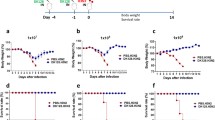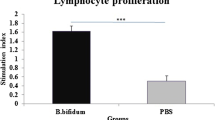Abstract
The protective effect of heat-killedLactobacillus casei (LC) against murine cytomegalovirus (MCMV) infection was examined. ICR mice treated once with LC 1 day or 2 days before challenge survived lethal infection, but untreated orLactobacillus fermentum (LF)-treated mice did not. The protective effect was evidenced by an increase in plaque-forming units (PFU) per 50% lethal dose (LD50) and a decrease in titers of infectious viruses replicated in the target organs. This was further confirmed by severity of histopathological damage to the target organs, especially the liver. LC neither inactivated MCMV nor inhibited its replication in mouse embryonic fibroblasts (MEF). The spleen cells from LC-treated mice inhibited its replication in MEF on co-cultivation. Augmentation by LC of splenic natural killer (NK) cell activity correlated with survival of mice from otherwise lethal MCMV infection. Cytotoxic activity of peritoneal cells and level of serum interferon (IFN) were elevated after MCMV infection, but they were not associated with survival of mice nor with treatment of LC. The protective effect of LC was not clear in NK-deficient beige mutant (bgJ/bgJ) mice, when compared with that in their littermate (bgJ/+) mice. Poor protection of bgJ/bgJ mice by LC treatment correlated with failure to induce NK cell activity by LC treatment in the mutant mice. Thus, it is likely that LC protects mice from MCMV infection by augmentation of NK cell activity.
Similar content being viewed by others
References
Piessens WF, Campbell M, Churchill WH. Inhibition or enhancement of rat mammatory tumors dependent on dose of BCG. J Natl Cancer Inst 1977; 59: 207–11.
Yasumoto K, Manabe H, Yanagawa E, Nagano N, Ueda H, Hirota N, Ohta M, Nomoto K, Azuma I, Yamamura Y. Nonspecific adjuvant immunotherapy of lung cancer with cell wall skeleton ofMycobacterium bovis bacillus calmette-guerin. Cancer Res 1979; 39: 3262–67.
Zbar B, Bernstein ID, Rapp HJ. Suppression of tumor growth at the site of infection with living bacillus calmette-guerin. J Natl Cancer Inst. 1971; 46: 831–39.
Cantrell JL, Wheat RW. Antitumor activity and lymphoreticular stimulation properties of fraction isolated fromCorynebacterium parvum. Cancer Res 1979; 39: 3554–63.
Conley FK, Remington JS. Effect ofCorynebacterium parvum on tumor growth in the central nervous system in mice. J Natl Cancer Inst 1978; 61: 461–64.
Woodruff MFA, Warner NL, Effect ofCorynebacterium on tumor growth in normal and athymic (nude) mice. J Natl Cancer Inst 1977; 58: 111–16.
Mashiba H, Gojobori M, Matsunaga K. Antitumor effect of combined use of OK-432 and yeast cell wall with mitomycin C in mice. Gann 1977; 68: 703–8.
Okamoto H, Shoin S, Kashimura S, Shimizu, R. Studies on the antitumor and streptolysin S-forming abilities of haemolytic streptococci. Jpn J Microbiol 1967; 11: 323–36.
Ota K (ed.) Clinical Application of OK-432 for Control of Cancer. Tokyo: Excerpta Medica, 1986.
Yamamura Y, Sakurai M, Ogura T, Azuma I. Adjuvant immunotherapy of lung cancer with BCG cell wall skeleton (BCG-CWS). Cancer 1979; 43: 1314–19.
Glasgow LA, Fischblach J, Bryant SM, Kern ER. Immunomodulation of host resistance to experimental viral infections in mice. J Infect Dis 1977; 135: 763–70.
Kirchner H, Scott MT, Hirt HM, Munk K. Protection of mice against viral infection byCorynebacterium parvum andBordetella pertussis. J. Gen. Virol 1978; 41: 97–104.
Bloksma N, De Heer, E, Van Dijk H, Willers JM. Adjuvanticity of lactobacilli I. Differential effects of viable and killed bacteria. Clin Exp Immunol 1979; 37: 367–75.
Kato I, Kobayashi S, Yokokura T, Mutai M. Antitumor activity ofLactobacillus casei in mice. Gann 1981; 72: 517–23.
Yasutake N, Kato I, Ohwaki M, Yokokura T, Mutai M. Host-mediated antitumor activity ofLactobacillus casei in mice. Gann 1984; 75: 72–80.
Miake S, Nomoto K, Yokokura T, Yoshikai Y, Mutai M, Nomoto K. Protective effect ofLactobacillus casei onPseudomonas aeruginosa infection in mice. Infect Immun 1985; 48: 480–85.
Watanabe T, Saito H. Protection of mice against herpes simplex virus infection by aLactobacillus casei preparation (LC9018) in combination with inactivated viral antigen. Microbiol Immunol 1986; 30: 111–22.
Minamishima Y, Eizuru Y, Yoshida A, Fukunishi R. Murine model for immunophylaxis of cytomegalovirus infection: I Efficacy of immunization. Microbiol Immunol 1978; 22: 693–700.
Kato I, Yokokura T, Mutai M. Macrophage activation byLactobacillus casei in mice. Microbiol Immunol 1983; 27: 611–18.
Sawai H, Ishibashi K, Itoh M, Watanabe S. 2′,5′-Oligoadenylate and 2′,5′-oligoadenylate phosphodiesterase in human plasma. Biochem Biophys Res Commun 1984; 125: 1061–6.
Bancroft GJ, Shellam GR, Chalmer JE. Genetic influences on the augmentation of natural killer (NK) cells during murine cytomegalovirus infection: Correlation with patterns of resistance. J Immunol 1981; 126: 988–94.
Bukowski JF, Woda BA, Welsh RM. Pathogenesis of murine cytomegalovirus infection in natural killer cell-depleted mice. J Virol 1984; 52: 119–28.
Ebihara K, Minamishima Y. Protective effect of biological modifiers on murine cytomegalovirus infection. J Virol 1984; 51: 117–22.
Grundy (Chalmer) JE, Trapman J, Allan JE, Shellam GR, Melief CJM. Evidence for a protective role of interferon in resistance to murine cytomegalovirus and its control by non-H-2-linked genes. Infect Immun 1982; 37: 143–50.
Okada M, Minamishima Y. The efficacy of biological response modifiers against murine cytomegalovirus infection in normal and immunodeficient mice. Microbiol Immunol 1987; 31: 45–57.
Quinnan GV, Manischewitz JE. The role of natural killer cells and antibody-dependent cell-mediated cytotoxicity during murine cytomegalovirus infection. J Exp Med 1979; 150: 1549–54.
Shellam GR, Allan JE, Papadimisriou JM, Bancroft GJ. Increased susceptibility to cytomegalovirus infection in beige mutant mice. Proc Natl Acad Sci USA 1981; 78: 5104–8.
Kato I, Yokokura T, Mutai M. Augmentation of mouse natural killer cell activity byLactobacillius casei and its surface antigens. Microbiol Immunol 1984; 28: 209–17.
Chong KT, Gresser I, Mims CA. Interferon as a defence mechanism in mouse cytomegalovirus infection. J Gen Virol 1983; 64: 461–64.
Roder J, Duwe A. The beige mutation in the mouse selective impairs natural killer function. Nature 1979; 278: 451–53.
Yokokura T, Nomoto K, Shimizu T, Nomoto K. Enhancement of hematopoietic response of mice by subcutaneous administration ofLactobacillus casei. Infect Immun 1986; 52: 156–60.
Macfarlan RI, Burns WH, White DO. Two cytotoxic cells in peritoneal cavity of virus-infected mice: Antibody dependent macrophages and non-specific killer cells. J Immunol 1977; 119: 1569–74.
Selgrade MK, Osborn JE. Role of macrophage in resistance to murine cytomegalovirus. Infect Immun 1974; 10: 1383–90.
Quinnan GV, Manischewitz JE, Ennis FA. Role of cytotoxic T lymphocytes in murine cytomegalovirus infection. J Gen Virol 1980; 47: 503–8.
Star SE, Allison AC. Role of T lymphocyte in recovery from cytomegalovirus infection. Infect Immun 1977; 17: 458–62.
Osborn JE, Blazkovec AA, Walker DL. Immunosuppression during acute murine cytomegalovirus infection. J Immunol 1968; 100: 835–44.
Manischewitz JE, Quinnan GV Jr. Antivirus antibodydependent cell-mediated cytotoxicity during murine cytomegalovirus infection. Infect Immun 1980; 29: 1050–54.
Osborn JE, Medearis DN. Studies of relationship between mouse cytomegalovirus and interferon. Proc Soc Exp Biol Med 1966; 121: 819–23.
Oie HK, Easton JM, Ablashi DV, Baron S. Murine cytomegalovirus: induction of and sensitivity to interferonin vitro. Infect Immun 1975; 12: 1012–17.
Wiltroth RH, Mathieson BJ, Talmadge JE, Reynolds CW, Zhang S-R, Herberman RB, Ortaldo JR. Augmentation of organ-associated natural killer activity by biological response modifiers. J Exp Med 1984; 160: 1431–49.
Author information
Authors and Affiliations
Rights and permissions
About this article
Cite this article
Ohashi, T., Yoshida, A. & Minamishima, Y. Host-mediated antiviral activity ofLactobacillus casei against cytomegalovirus infection in mice. Biotherapy 1, 27–39 (1989). https://doi.org/10.1007/BF02170133
Received:
Accepted:
Issue Date:
DOI: https://doi.org/10.1007/BF02170133




